In the world of architecture and in&outdoor design, a solution stands out for its harmonious balance between shape and function: the enclosed bioclimatic pergola. This kind of protection embodies indeed an idea of elegance and refinement offering, at the same time, an immersive open-air experience.
Already undisputed protagonists of gardens and terraces, the enclosed bioclimatic pergolas allow you to enjoy the wellness coming from the outdoors in harmony with nature all year round. Nevertheless, is when winter comes that these structures reveal their great efficacy: thanks to the adjustable sunshade blades and the perimeter glazing, they become a comfortable shelter while the cold outside envelops the world outside.
- Enclosed pergola
- How to close the pergola
- Closure systems for pergolas
- Winter pergola
- Bioclimatic pergola in winter
- Enclosed bioclimatic pergola: authorisations
1. Enclosed pergola
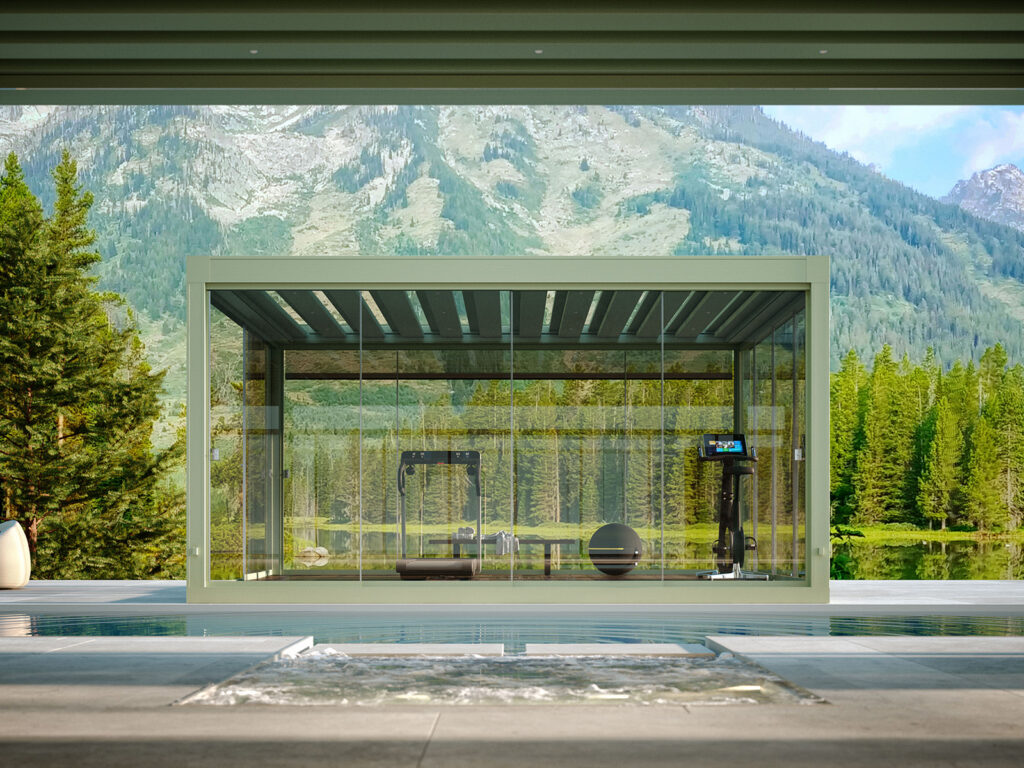
Breaking down any barrier between natural and human element, between any indoor and outdoor living space. Thanks to a design fully customisable, the enclosed pergola combine the advantages of a cosy and sheltered space with the charm of spending time overlooking the landscape. The versatility and the technology of these structures make them perfect for any season, since they make it possible to adjust the opening and protection degree of the pergola, thus creating the best climate conditions and not only. This way, the enclosed bioclimatic pergolas enhance the outdoor space that becomes usable all year round and at any latitude, as it was an additional space of your house or restaurant.
In residential contexts, the enclosed pergola may become a bright studio surrounded by greenery, but also another living room, a relax room for reading or hobbies. In harmony with the building, with a unique panoramic view and a pleasant privacy.
The makings of the enclosed pergolas are innovative frontiers also for the Ho.Re.Ca. and wellness sectors, where their success derives from the possibility to wider efficaciously the surface at disposal, by increasing the guests’ comfort and offering a persuasive wellness experience. So here are restaurant halls, lounges, bars, as well as gyms and spaces dedicated to wellness and self-care moving outdoors, in a perfect combination of style, functionality, and suggestion.
2. How to close the pergola
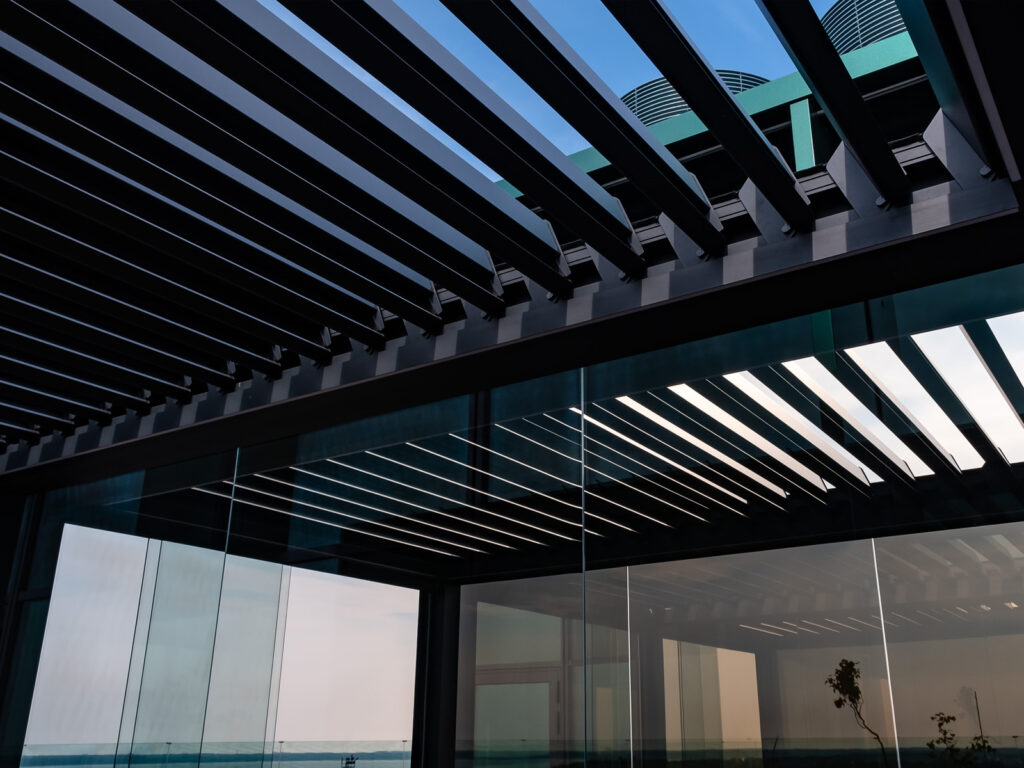
As the weather changes, the pleasure of enjoying outdoor spaces remains a constant thanks to the possibility of closing the pergola along the perimeter and on the zenith plane.
The result is a true open-air room, whose walls open and close as required and the ceiling allows the sky to come in, thanks to the automated movement of the elegant aluminium sunshade blades adjusting in a natural and sustainable way light and ventilation.
Among the many solutions to close the pergola, you can choose between three different kinds of covering, all automated and manageable through cutting-edge home automation systems:
- with adjustable blades, that rotate from 0 to 140 degrees and reach any intermediate position;
- with retractable blades, sliding and compacting with a fast and silent movement, and opening a big window on the sky;
- with alternate overlapping blades, so that the movable blades lift and slide, until disappearing on the fixed ones, following the natural movement of the sun
Thanks to the full closure of the covering, and to a precise combination of profiles and seals, light rain and snowfall no longer interrupt the outdoor wellness experience. With a simple gesture, a voice command or the automated activation of weather sensors, the space is sheltered and rainwater conveyed into a perimeter gutter system concealed in the posts.
3. Closure systems for pergolas
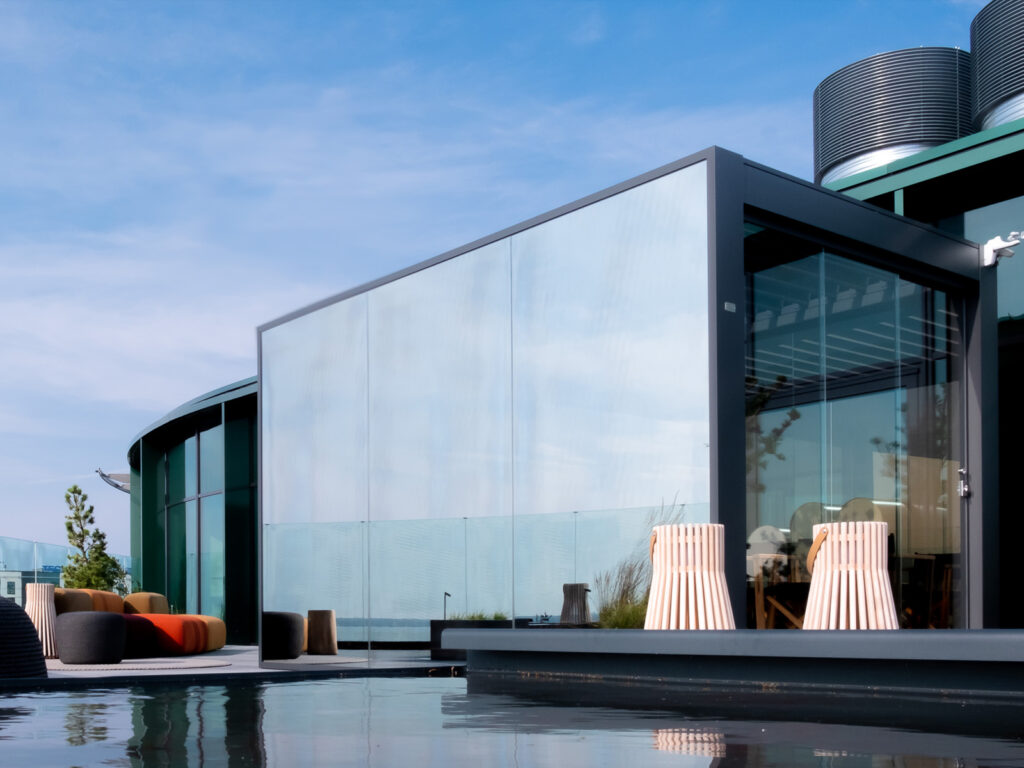
Ogni spazio esterno, dal balcone, al terrazzo e al portico, può riassumere luminosità, protezione e versatilità con i sistemi di chiusura per pergole. L’utilizzo di vetrate perimetrali permette infatti di schermare completamente l’ambiente, pur continuando a beneficiare di una visuale panoramica e del contatto diretto con il paesaggio circostante.
Solitamente realizzate in vetro temprato trasparente, le vetrate della Glass Series Pratic, ad esempio, sono certificate per la loro resistenza ad aria, acqua e vento, oltre a offrire riparo contro pioggia, rumore e polvere. La soluzione perfetta per chi desidera creare uno spazio open air da vivere oltre la sola bella stagione. Ma scegliere i sistemi di chiusura per pergole più adatti alle proprie esigenze implica considerare non solo la funzionalità, ma anche estetica e stile. Ecco allora che in aiuto arrivano modelli dal design essenziale e privo di elementi tecnici a vista, declinabili in tre differenti opzioni:
- le vetrate fisse sono realizzate da pannelli singoli, uniti tra loro da discrete guarnizioni vetro-vetro e assicurati alla struttura della pergola con eleganti profili in alluminio;
- a completamento di queste, le vetrate a porta battente regalano un accesso raffinato alla pergola, che si completa di pannello fisso superiore, controporta e ricercati accessori in acciaio satinato;
- le più diffuse sono invece le vetrate a scorrimento, per la loro capacità di aprire e chiudere totalmente gli ambienti della pergola a seconda delle esigenze. Nei modelli Pratic, lo scorrimento su binari è celato all’interno di montanti e pavimentazione per un effetto curato e minimale.
Non meno importanti, nella scelta dei giusti sistemi di chiusura per pergole sono le finiture. Queste fanno infatti la differenza dal punto di vista estetico e della potenzialità di utilizzo della schermatura.
- le vetrate trasparenti sono ideali per dehors capaci di catturare tutte le sfumature della luce, senza soluzioni di continuità tra in&outdoor;
- le vetrate fumé e satinate assicurano una riservatezza dall’effetto estetico originale;
- le vetrate specchiate riflettono in diretta il paesaggio circostante, diventandone parte attiva. Dall’interno la visuale panoramica è garantita, mentre la pergola risulta impenetrabile a uno sguardo esterno, regalando una privacy mai sperimentata prima.
Any outdoor space, from the balcony to the terrace and the porch, may summarise brightness, protection and versatility, through the closure systems for pergolas. The use of perimeter glass walls allow you to protect completely the space, while still benefiting from a panoramic view and direct contact with the surrounding landscape.
Usually made of transparent tempered glass, Pratic’s Glass Series glazing are certified for their resistance to air, water and wind, as well as being a shelter against rain, noise and dust. The perfect solution for those who wish to create an open-air space to live all year round. Choosing the most suitable closure systems for pergolas implies considering not only the functionality but also design and style. That’s why models characterised by an essential design without any visible technical parts come into play; there are three different options:
- fixed glass, that are single panels, joined by means of discreete glass-glass gaskets and secured to the pergola’s structure through elegant aluminium profiles;
- to complement these, hinged door glazing provides a refined access to the pergola, which comes with an upper fixed panel, a counter door and refined frosted-finish steel accessories;
- the most popular are the sliding glass walls, for their ability to open and fully close the pergola as required. In Pratic’s models, the sliding on rails is concealed within the posts and the flooring for a neat and minimalist effect.
Last but not least, the finishes. These make all the difference in terms of aesthetics and use of the sunscreen.
- Transparent glazing is ideal for dehors capable of capturing all shades of light, with no interruption between indoors and outdoors;
- smoky grey and frosted glass walls ensure privacy with an original aesthetic effect;
- mirrored glazing reflect live the surrounding landscape, becoming an active part of it. From the inside, a panoramic view is guaranteed, while the pergola is impenetrable to an outside gaze, providing unprecedented privacy.
4. Winter pergola
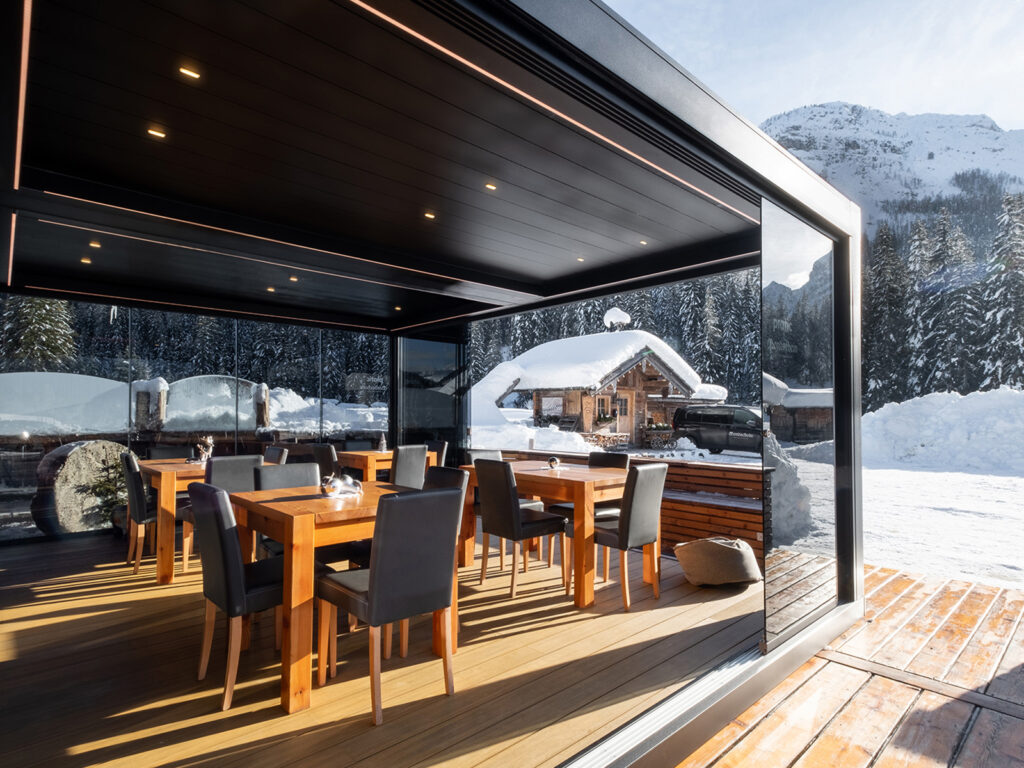
Benefiting from natural light exposure even when it gets colder while enjoying the charm of natural surroundings and the comfort of a protected space. The winter pergola makes all this possible thanks to its architecture, designed to allow sun fill and warm the room beneath.
Although they are not insulating windows and doors, the glazing of winter pergolas also helps to soften the temperature within the open-air space. Yet when natural sunlight is not enough, customised heating systems, such as pits, heat lamps and heaters furnish the patio and make it suitable to be used even in chilly seasons.
Furthermore, the integrated LED lighting overcomes the absence of light during the shortest days of the year, thus allowing outdoor spaces to be used even after sunset. Such an advantage is highly appreciated in regions with few hours of sunlight.
5. Bioclimatic pergola in winter
Just like winter gardens with glazed walls and roofs, the enclosed bioclimatic pergola can become a welcoming extension of your own home too, hence providing a custom-made corner for relaxation, hobbies or work. Moreover, the bioclimatic pergola in winter can serve as a cosy veranda or a winter garden, where to place small trees, plants and flowers, thus creating a unique room where to fully immerse yourself in nature.
A further plus of coverings with movable sunshade blades is the ease of ventilation for the bioclimatic pergola in winter as well as the possibility to let light in from the roof, thus making the underlying room a highly versatile and ventilated space during warm days. Besides that, the enclosed bioclimatic pergolas mounted on the wall allow to improve the indoor temperature: more insulted rooms in winter and cooler in summer also by means of vertical awnings providing greater shade.
6. Enclosed bioclimatic pergola: authorisations
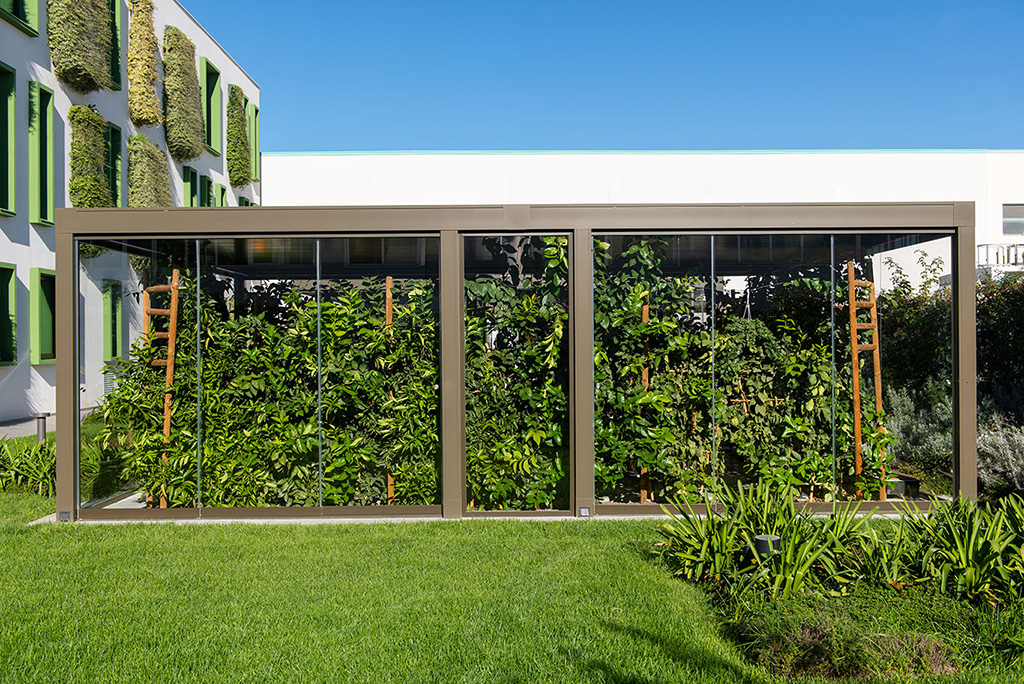
Before planning the extension of a public or private building by installing an enclosed bioclimatic pergola, a few preliminary checks concerning authorizations have to be carried out. Indeed they may vary depending on the region or district where you wish to build your own outdoor space. Usually, the installation of an enclosed bioclimatic pergola implies also an increase in building’s volumetric dimension, especially when the shading system is seamlessly attached to the house.
While not representing a real fixture, the outer glazing as well as the glass sliding doors delimit the structure all around, resulting in a new closed volume. Should it be recognised as a minor outbuilding in the project submitted by the City Council, the enclosed bioclimatic pergola requires then the building permit as well as the SCIA Certified Report of Start of Activity and the fulfilment of the related fiscal requirements.
This is why, when planning, a good practice is to seek the help of qualified dealers and professionals in the field, who can always provide a custom-made product and meet all requirements and authorizations for the installation of an enclosed bioclimatic pergola.